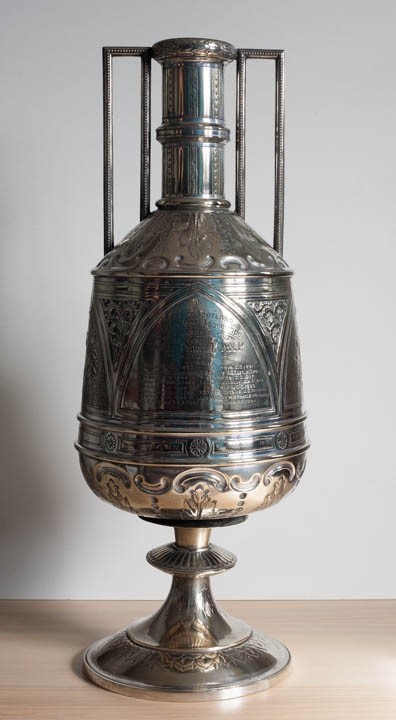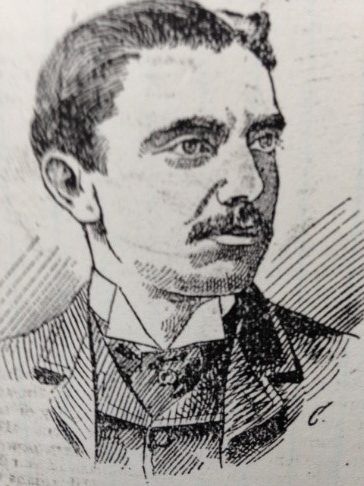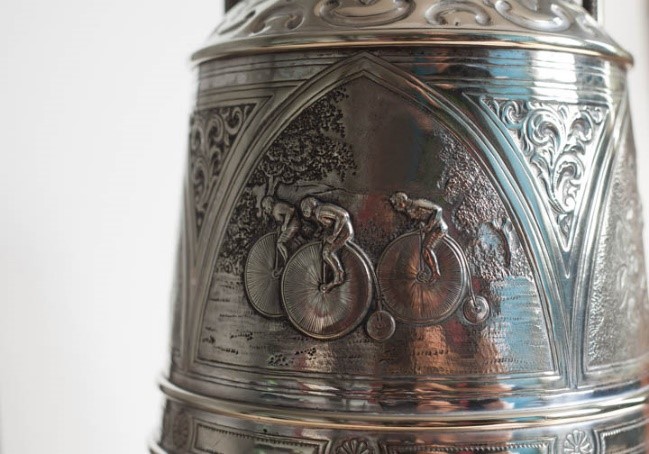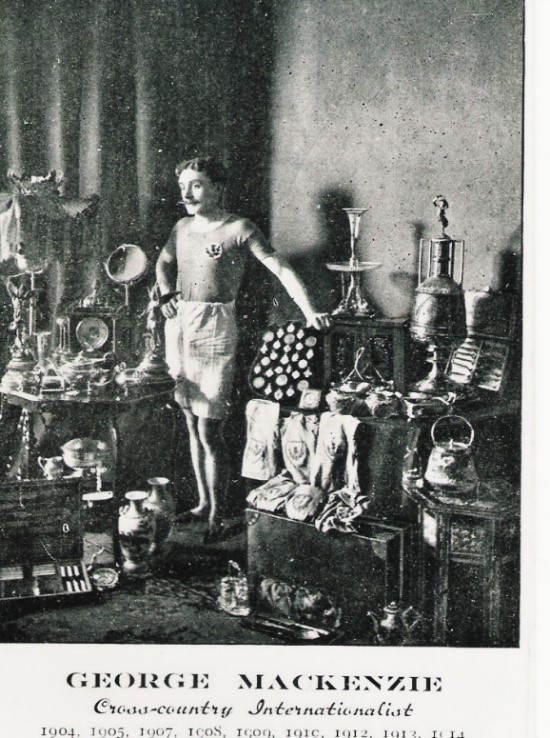Scottish harrier club histories contain a relatively rich seam of information of cups and trophies donated by patrons and benefactors as well as former members. Indeed, one of the reasons for enticing members of parliament, civil dignitaries and the like to become patrons, was often in the hope that some item of silverware might be forthcoming. The Pearce Cup was one such example albeit a fortuitous windfall for one harrier club.
The West of Scotland Harriers were formed in 1886 following on from Clydesdale Harriers and Edinburgh Harriers. In the mid-1880s, membership of sports clubs was something of a collector’s hobby and the new harriers’ clubs had members from a range of sports, principally amongst them were rowers, cyclists and footballers. The West of Scotland Harriers in particular contained a strong, active membership of both cyclists and footballers as did Clydesdale Harriers. John Meikle was a member of both the West of Scotland Harriers and Bellahouston Cycling Club.
John Meikle
Meikle was a founding member of the West of Scotland Harriers in 1886 and had experience of both cross-country running and cycling before helping form ‘The West’. As ‘The West’s’ membership grew, so too did engagement with other clubs for fixtures and of course prizes for special ‘challenge’ races. The peculiarity of the Pearce Cup was that it served two functions in its lifetime. Initially a cycling Cup, it was taken into ownership by a harriers’ club through the influence of Meikle with the harriers’ club continuing to put it forward for cycle races which it staged until the club used it for cross-country purposes. The trophy was titled the ‘West of Scotland Cyclists Meet Association Challenge Cup’, a title which in itself challenged the engraver to be able to fit it all on one aspect of the cup. The trophy stands (without plinth and top) at 56 cms. high, 21cms. in diameter and weighs 3.2 kilos and is of silver gilt.
Funds for the trophy were donated by William Pearce to the West of Scotland Cyclists Meet Association in 1886. However, the Association soon became defunct, presumably as a consequence of the developing schism in cycling at the time relating to issue of the National Cyclists Union and the twin issues of racing on roads and Scotland wishing to run its own affairs. The West of Scotland Harriers took over some of the duties of the West of Scotland Cyclists Meet Association by virtue of John Meikle being appointed a ‘pro tem’ secretary of the Meet Association in 1887 as it struggled to continue amongst growing ‘animus’ between clubs and individuals. Meikle, seen as a known and politically safe pair of hands in the continuing war of words in the struggle for oversight of cycling in Scotland, was therefore in a position to acquire the trophy in 1888 for the West of Scotland Harriers (who had significant numbers of cyclist members) on the demise of the Association after the first Pearce Cup race in 1887. Given that by 1888, there were only about 20 Harrier clubs in existence, the Pearce Cup remains one of the oldest Scottish Athletic trophies still in existence. The first winner however, is recorded as Lanarkshire Cycling Club.
A note about Sir William Pearce helps. It is clear from the press of the day that he was a great benefactor of a range of social and civil activity. His connections and philanthropy extended from another Pearce Cup donated to Bellahouston Baths Company for swimming competition and to the Glasgow Agricultural Show for the best 2year-old filly. He also funded the Pearce Lodge of Glasgow University which then was used for students of naval architecture. Born in Kent in 1833 he trained as a naval architect and moved to Scotland when appointed manager at Napier’s shipyard in Govan. He rose steadily into partnership and then sole owner and the company was renamed the Fairfield Shipbuilding & Engineering Company, specialising in large vessels such as passenger liners and warships employing at its height some 5,000 people. Like many successful businessmen of the day, he felt the draw of politics, as this would be where he could be close to decision-making and help shape the industry in which he was a key player. He was elected as the first MP for Govan in 1885 (Conservative) and created a Baronet in 1887. However, he died suddenly in 1888 aged 55 years. He was also a Grand Master of the Provincial Lodge of Glasgow another social institution which gave opportunity to mix and mingle with civic figures of Glasgow.
The inscription on the trophy reads William Pearce rather than Sir William Pearce and given the social niceties of the day, it therefore seems likely that the funds donated for the cup just predated the first 1887 competition and were given whilst still plain William, but just before his award of the Baronetcy. By all accounts he could afford his philanthropy. His estate at death was valued at £1,069,669 which in 2020 is worth just under £140m. His widow, Lady Dinah used the inheritance to help the local community of Govan, in particular donating funds to build the Pearce Institute still in operation today as an events venue on Govan Road. There is a statue adjacent to the Institute erected in 1894.
The trophy itself is now missing its top and plinth, but is still an unusual and impressive trophy although no longer in use. The original races became the foremost cycle races in the west of Scotland cycle racing calendar and were to take place in June of each year over not less than 25 miles and not more than 50 miles. It was a team race of 3 cyclists. From the outset the race was promoted as a road race and not a path race, a detail which ultimately led to its demise as a cycle race due to safety considerations. From the first winners in 1887 of the Lanarkshire Cycle Club, there was an unbroken run until 1895.
Accounts of the race day of the cyclists’ border on the chaotic. By 1888, when Meikle himself was selected for the Bellahouston CC for their Pearce Cup team, the local press in a kind, but probably honest appraisal of him, talked of him as ‘having practically given up training’ but ‘clearly (able to) demonstrate his latent powers’ as ‘a man out of training’. In the account given of the Pearce Cup race of 1888 it is easy to see how his condition mitigated against a decent performance.
‘The usual amount of false alarms took place while the men were away. First of all, in came J Meikle, at a whacking pace, who was thought to have done the distance in record time. Great, indeed, was the disappointment felt when we were informed that John had dismounted to smoke a cigarette which had been given to him on the road. After smoking for a bit he thought the men had got rather too much of a lead, so did not try to catch them, but came home instead.’
Race day at Lanark was clearly carnivalesque. At the Clydesdale Hotel, Lanark there was ‘a most severe feed’ but described by the dining cyclists as ‘only a bit of steak tea’. Passing the time while the cyclists were away, the spectators indulged in foot races for wagers and betting on the result of the cycle race with sums of up to £3 being offered on a Motherwell victory by a drunk Motherwell supporter who then resorted to wanting to ‘rin ony man a hunner yards fur a boatel o’ whiskey.’ John Meikle seemed in good company. Meikle later took up yacht racing.
Despite the rather ‘loose’ approach to race preparation and organisation, the early years of cycle competition saw Maybole CC achieve an outstanding ‘3-in-a-row’ with one rider, WN ‘Wumphy’ Allan riding in all three victories; never again achieved. The Maybole team of 1890, the last of their three victories, was made up of the three Allan brothers, RF Allan, WN Allan and TK Allan. In their first win in 1888, Lees rode a trike. In the period from 1887 until the last cycle race for the Cup in 1899, six teams won the trophy. The achievement of the Maybole club was due in part to the huge interest in sports at that time. There was certainly evidence that in Maybole and in Ayrshire more generally, both cross-country running and football was part of the fabric of recreational activities of young men and Maybole had its own history of runners such as Robert McKinstray and James Rodger who was a founding member of Carrick Harriers formed in November 1889. A full list of cycling club winners is appended at the end of this piece.
As the cycling fraternity became more organised and the sport grew and with the technical advances in cycle engineering and construction (eg. pneumatic tyres), other races soon took precedent. In 1895 the West of Scotland Harriers took the decision to suspend the race after the Scottish Cyclists Union forbade licensed riders of the SCU to compete. The date had been changed from a May/June race to September and it may well have fallen foul of the new SCU calendar (Scottish Cyclists Union formed in 1889) as well as cycling politics of the day. However, it was resurrected in 1897, but with only 5 entries it struggled to gain a foothold amongst the cycling fraternity. By 1899 the final cyclist’s winners of the trophy were Wishaw Cycling Club. The cycling world had moved on from Harriers clubs offering cycle races. The trophy which at the outset was ‘the absolute possession’ of the West of Scotland Harriers was intended to keep the trophy in the possession of the club as it was customary at the time for any individual or club winning any trophy three times in succession, to be able to lay claim to keep the trophy. The ‘absolute possession’ phrase thus prevented Maybole Cycling Club, winners in 1888, 1889 and 1890 from keeping the trophy and would also prevent any future three-time trophy winners likewise.
The trophy now became part of the fabric of the West of Scotland Harriers to be awarded annually to the club champion for winning the club cross-country championship over 8mls. The first winner in 1900 was JJ McCafferty, one of two brothers who joined the West of Scotland Harriers (the other brother PJ McCafferty joined ‘The West’ later from Celtic Harriers). Of particular note was the prolific ‘West’ harrier, George Mackenzie. A slight man, he was to become one of the stalwarts of the Scottish International team between 1904 and 1914, competing in nine International Championships. He won the Pearce Cup (club cross-country championship) five time including a treble in 1908, 1909 and 1910. Mackenzie was also part of the West of Scotland Harriers team that won the NCCU of Scotland Championships in 1905 for the first time. He went on to win 3 further National team championships with the ‘West’ but the individual title eluded him. Mackenzie contributed to the war effort by training troops on Musselburgh beach and when he finished his running career, opened a sports’ outfitters in Edinburgh. The picture below depicts Mackenzie with a substantial array of prizes and trophies and the William Pearce Cup is on the far right at waist level with a figurine on the top.
Only three other athletes of the ‘West’ would win the Cup three times or more; GH Davidson, A Spencer and AL Spencer (who won it 4 times) and only Davidson and AL Spencer managed ‘3-in-a-row’.
As was the case with many clubs, the fortunes of the club waned after World War 2. The Pearce Cup was only sporadically put up for competition after the war as membership was relatively low, and by the early 1960s numbered only a few dozen. Both RJ (Bob) Smith, a former member in the 1930s, and Johnny Todd, who coached the youngsters, were energetic in keeping the club going and there was a mini revival in the early to mid-1960s. Despite some noted runners (and indeed a few internationals), there was insufficient competition to merit individual club championships although in 1966 there was an attempt to run a track and field championship for the younger members but this only numbered 6-8 members. In cross-country any attempt to assume the mantle of club champion was by placing in the National Cross-Country Championships thus the Pearce Cup had effectively disappeared from 1945. Senior membership numbered literally only a handful of active runners and the only notable success over the country was in the form of a Youth team that placed 6th in the national cross-country championships in 1967.
However, in the 1970s the Pearce Cup re-appeared with Davie Wyper the recipient. David was a superb marathon and ultra-runner and in 1972 he placed second in the Edinburgh to North Berwick road race over the marathon distance (2hrs. 24mins. 50secs) and then went on to win the race in 1976 and 1978 over a shorter distance with a time of 2 hrs. 01min. 50secs in 1976. David received the Pearce Cup from 1972 until 1979 when it was handed back to the club on its disaffiliation.
The West of Scotland Harriers effectively disaffiliated from all county and national bodies in 1978 with the records showing a fee paid to Renfrewshire AAA of £1.50 on 26th November, 1977 for season 1977-78. Some members continued to pay subscriptions in order to keep the name alive, but the club effectively dissolved in the 1980s. In what was the last act of the (very few) remaining members, an approach was made to the then SAAAs to take the club trophies (and with them a significant chunk of Scottish athletic history) in order that they be re-used. While the SAAAs took the WG Wylie Cup for an indoor Octathlon championship, the Sir John Ure Primrose Cup for indoor pole vault and the Warren Challenge Cup for the men’s 60metres indoors, they opted not to take the William Pearce Cup. Presumably, with the others being of silver and the Pearce Cup gilt, there was not the same incentive. The trophies were handed over at a ceremony at the Scottish National Championships at Crownpoint, Glasgow in July, 1989. The William Pearce Cup is still in the possession of a former West of Scotland Harrier.
Appendix 1
| William Pearce Cup winners – cycling | |||
|---|---|---|---|
| 1887 Lanarkshire CC | 1888 Maybole CC | ||
| 1889 Maybole CC | 1890 Maybole CC | ||
| 1891 Cathkin CC | 1892 Northern CC | ||
| 1893 Northern CC | 1894 Cathkin CC | ||
| 1895 No competition | 1896 No competition | ||
| 1897 Carrick CC | 1898 Wishaw CC | ||
| 1899 Wishaw CC |
Appendix 2
William Pearce Cup – West of Scotland Harriers Cross-Country Champion
| 1900 JJ McCafferty | 1901 JJ McCafferty | ||
|---|---|---|---|
| 1902 WT Marshall | 1903 PJ McCafferty | ||
| 1904 Thos. Mulrine | 1905 Geo. Mackenzie | ||
| 1906 Thos. Mulrine | 1907 Wm Bowman | ||
| 1908 Geo. Mackenzie | 1909 Geo. Mackenzie | ||
| 1910 Geo. Mackenzie | 1911 Harry Hughes | ||
| 1912 Geo. Mackenzie | 1913 Geo. Mason | ||
| 1914 David Peat | 1915 No competition | ||
| 1916 No competition | 1917 No competition | ||
| 1918 No competition | 1919 No competition | ||
| 1920 GH Davidson | 1921 GH Davidson | ||
| 1922 GH Davidson | 1923 BS Passmore | ||
| 1924 CH Freshwater | 1925 RB McIntyre | ||
| 1926 RB McIntyre | 1927 BS Passmore | ||
| 1928 A Spencer | 1929 A Spencer | ||
| 1930 SK Tombe | 1931 WS Fisher | ||
| 1932 A Spencer | 1933 AL Spencer | ||
| 1934 AL Spencer | 1935 AL Spencer | ||
| 1936 A Spencer | 1937 no record found | ||
| 1938 no record found | 1939 no record found | ||
Ackowledgements and sources
The Maybole history group and Rich Pettit in particular were a good source of sporting (and other) history and made valuable suggestions. https://www.maybole.org/history/books/carricks%20capital/sport.htm
As always, the British Newspaper Archive was invaluable in both bringing to light further material as well as substantiating sources and information
Membership handbooks of the West of Scotland Harriers were used to gather more detailed information up to 1939 (possession of the author).
Norrie Dallas provided photographs of the cup from photographs in his possession, plus further information and support for this article
The etching of John Meikle is taken from The Scottish Umpire, Sept 6th, 1887. The Scottish Umpire was accessed at the Mitchell Library, Glasgow.
The photograph of George Mackenzie forms part of the author’s materials on the West of Scotland Harriers.
The material on William Pearce was accessed largely at Glasgow City Archives number GC 920. 04. BA
Further material on Pearce was accessed at the University of Glasgow, the University of Glasgow Story at https://www.universitystory.gla.ac.uk/biography/?id=WH0159&type=P
Hamish Telfer



